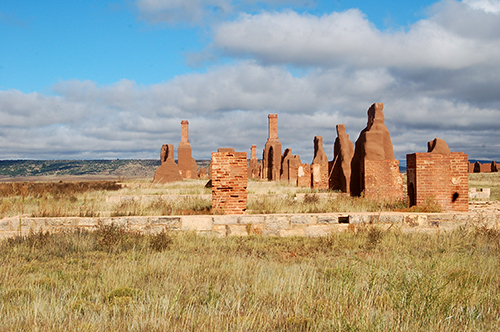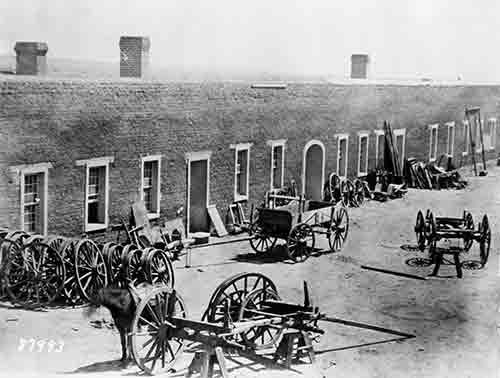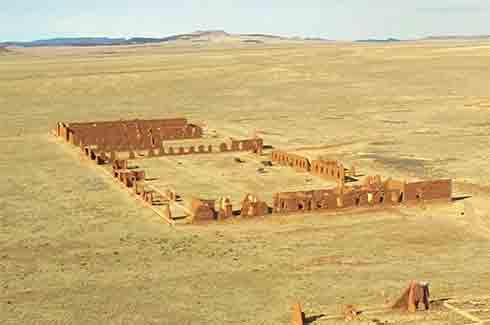|
|
|
The adobe
walls of Fort Union stand at all heights, some leaning and twisted,
others with only the foundations defining former buildings, and
brick
chimneys dramatically rising above the walls. Rectangular voids in the
adobe walls once
served as
doors and windows and some are framed by wooden lintels. Today, there
are no roofs, to shelter and protect exposed walls from the elements.
|
|
 |
| A view looking north down the line
of the Officer's Row as it appears today. |
|
|
Between 1851-1891, the fort functioned as an
active military
depot and was the largest military post west of the Mississippi.
Situated on
the Santa Fe Trail, the ruts of the wagons are still
visible
today; Fort Union earned the reputation as the “guardian of the
Santa Fe
Trail.”
Fort Union was constructed in three phases: the First Fort (1851),
the
Second or Star Fort (1861, demolished 1866) and the Third Fort
(1863-1868).
Today, the Third Fort is the most actively interpreted of the three by the
National
Park Service and is open to visitors.
|

|
The
Mechanic's Corral during the period when the fort was still an active
military outpost.
Image source: Arrott Fort Union Collection
at the Special Collections & University Archives, New Mexico
Highlands University. |
|
|
| The third
iteration of Fort Union
was more architecturally sophisticated than its predecessors with an
organized
grid plan and Territorial Style buildings of adobe walls, stone
foundations,
and brick chimneys. In 1891, Fort Union was abandoned. By the end of
the 19th
century, with the end of the Indian wars and the arrival of the railroad, there was no longer a need for the
Santa Fe
Trail nor the military posts like Fort Union that had defended it. After
the fort was abandoned in 1891, it was set upon by locals who removed
woodwork and other valuables and the adobe walls were left to weather
and
deteriorate. All earthen sites are
extremely
vulnerable to moisture and their deterioration will quickly advance as
a
result of missing architectural elements such as
roofs. Fort Union National Monument is no exceptio, its archaeological,
architectural and cultural landscape evolving over time to both weather
and preservation. |
|
|
|
|
 |
|
| Established
in 1964, Fort Union National Monument, New
Mexico, is the largest earthen ruin in North America, and commemorates
the
United States’ expansion of the American frontier during the age of
Manifest
Destiny. |
|
|
|
Efforts to conserve Fort Union National Monument began with
its stabilization in 1956 following its inscription as a
National Monument two years prior.
Founding legislation for Fort Union mandates that the site be preserved
as a
"stabilized ruin". Early preservation efforts conducted
between 1956
and 1961
included excavation, stabilization of the adobe walls, cisterns and chimneys, the insertion of wall bracing and
rebuilding
of corners and window openings supporting wooden lintels. In keeping with the original
mandate, only a small number of leaning walls
were
straightened.
The practice of shelter coating the adobe walls as a
maintenance
technique began in 1963. Amended soil-cement mixtures and applied chemical consolidants were used until the 1980s when the park
service reverted to using
more
traditional unamended methods of adobe conservation.
Earthen shelter
coats, which have proven to be effective protection for the original adobe, continue to be
employed at the monument. In
2016, in
partnership with the Vanishing Treasures Program, the park staff at
Fort
Union
conducted a successful straightening of a leaning wall at the
Hospital
building. While the process was effective it was apparent that it would
not be a viable option for all leaning walls at the park, due to high costs.
|
|
|
 |
A view of the Mechanics Corral and Depot buildings looking north.
|
|
|
|
| A view of the historic sundial with the Mechanics Corral in the distance. |
|
|





